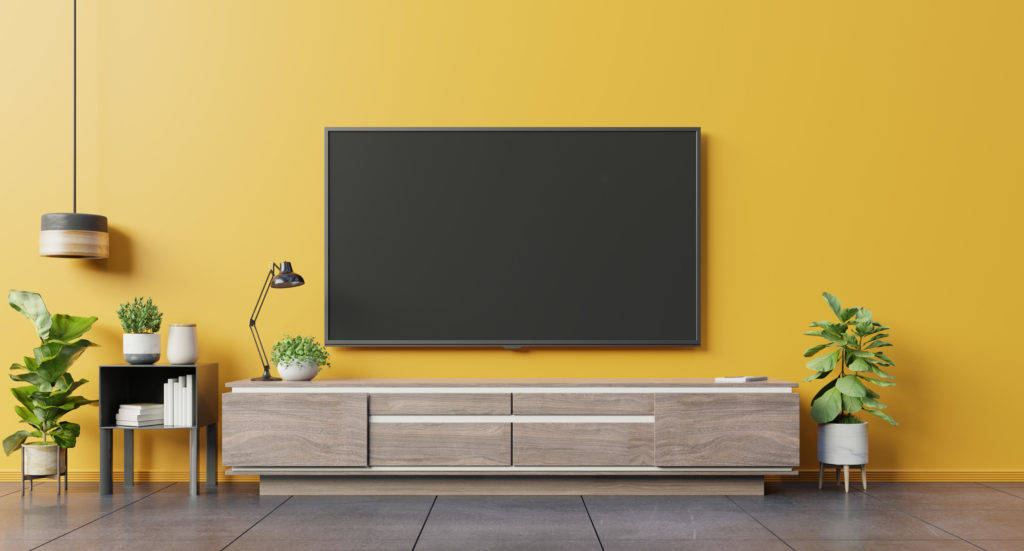
Image: Vanit Janthra
Tips on Smart TVs That Make the Most of Your Gig Service
Ready for a new TV? The latest smart TVs take advantage of the high-quality streaming provided by gig internet service, so you can watch your favorite show with stunning picture quality.
Screen options this year include a dizzying array of technologies such as 4K, 8K and Mini-LED. New TVs offer the convenience of built-in apps to watch shows on streaming services such as Netflix and Hulu. To take advantage of these TVs, you’ll need the fastest internet service you can get to provide the best streaming quality. If your internet service provider offers gig speed, it’s a great choice.
Here’s what gig service means for you
Gig—or Gigabit—is currently the fastest internet connection you can get in your home. This speed of 1000 Mbps is most often delivered over a fiber optic network, transmitting data to and from your home through pulses of light that are both fast and resistant to bad weather.
That high speed means that streaming is generally free from buffering and slow load times. What’s more, it will support several TVs and devices all streaming great movies and shows at the same time.
The current standard for excellent picture quality is a 4K TV. The new high-definition screens get the best picture quality from streaming services that send a lot of information via the internet to your TV. If you don’t have superfast internet, you won’t get the best picture.
Getting the latest smart TV up and running online is usually just a matter of following a few simple steps on the screen during the setup process to connect to a Wi-Fi network. All new TVs these days have Wi-Fi. However, you might want to consider joining your TV to your router with an Ethernet cable. Some experts claim that using a cable will give you a faster and more reliable connection than Wi-Fi.
With gig speed, check out new TV tech launched at CES
The cutting-edge TVs unveiled at this year’s Consumer Electronics Show (CES) in January boast new levels of resolution and brightness. If you’ve got thousands of dollars to spend, you can get incredible screen quality that will make it seem like you’re in a movie theater. For those on a smaller budget, the exciting news is that the price of new technologies, like 8K, is dropping fast.
Samsung introduced a new line of displays at CES called Neo QLED, which adds Mini-LED backlighting to the quantum dot technology used in its existing QLED series. The technology allows dark parts of the picture to stay dark while bright parts of the image get more brilliant.
TCL showed off its new OD Zero Mini-LED with “tens of thousands” of mini LEDs and thousands of local dimming zones. The company says the latest screen technology will provide a better picture and be available later this year.
Resolution is the solution
To get the best picture, make sure your TV has the highest resolution you can afford. The standard these days is 4K. The good news is that high-quality 4K TVs have dropped in price significantly and can be found for well under $1,000.
The cutting-edge screen resolution this year is 8K technology, but it’s costly and currently supported by only a few streaming services. The good news is manufacturers revealed at CES that they’re starting to sell TVs with 8K technology that are relatively affordable. It’s clear that 8K will eventually be the standard resolution, so if you want to buy a TV that will last for years, consider investing in a model that has this capability.
Mini-LED vs. Micro-LED
Two important trends in TVs this year are emerging display technologies like Mini-LED and Micro-LED. As a refresher, LED stands for light-emitting diode, and it’s the part that glows when current passes through it.
Mini LEDs are smaller than the average LED, so more of them can be crammed together in the same area. The increased number of LEDs means you can have a hundred or more discrete dimming zones on the screen, leading to better contrast.
Consider a Mini-LED TV that offers excellent picture quality at a much lower price than an OLED model (discussed below) if you are on a budget. You can find a 65” 4K TV with Mini-LED technology for under $1,000, such as this TCL model, which boasts a Roku interface.
Micro-LED technology packs in even smaller LEDs than its big brother Mini-LED. This new technology promises to provide some of the brightest and most vivid colors yet available. These devices are just starting to hit the market, so if you decide to invest in a Micro-LED TV, keep in mind that the screen sizes available now are huge and cost megabucks. Samsung’s 110-inch Micro-LED costs around $150,000. Probably not in the budget, but it’s fun to look.
OLED gets affordable
Some of the best TVs on the market offer screens with OLED, which stands for organic light-emitting diodes. An OLED display works without a backlight because it emits visible light, so it displays deep black levels and can be thinner and lighter than other models. An excellent smart TV with an OLED display and 4K resolution can be found for under $2,000, such as this 55” model by LG.
When you want to go all out for a TV with the best picture quality, look for an OLED screen with great color and good sound quality. Some of the best TVs in this class are made by Sony, such as the Bravia A8H, which can be found online for around $1,900.
Speed and connection make a great picture
Whatever TV you choose, make sure that you’re feeding it fast data with a gig internet connection. You’ll appreciate the difference in picture quality during many hours of happy viewing.
Product features, availability and prices may have changed and are subject to change.




Join the conversation